all travel ideas for your Ethiopian journey along the historic route and on the highlands
Isolated in the extreme north of the country, Axum is the birthplace of one the most important Ethiopian civilisations. Founded more than 3000 years ago during the reign of Queen Sheba, the Kingdom of Aksum capital’s radiation extended from Yemen to Sudan. It had the monopole for trade in the whole Red Sea region and has developed trade relations with Egypt, Mediterranean empires and even India. Moreover, the name of Axum is mentioned in many writings, such as the Greek Ptolemy’s “Geography”. Nowadays, Axum - figuring on the UNESCO’s World’s Heritage list - still abounds in historical sites: imposing obelisks, ruins of ancien palaces, chiselled tablets and other antiques dating back from the days when the city was still rivalling with the greatest empires of its times.
Not far from the city, you will find one of the oldest standing structures in Ethiopia: the Yeha Temple. Dated to the 5th century B.C., the building could be - according to some experts - even older than that. Erected in what would then be the pre-aksumite’s capital by populations of South-Arabic origins, the temple was dedicated to the Sabean god Almaka. Besides the temple’s ruins, the enclosure shelters a church from the 6th century dedicated to Abba Aftse (one of the 9 Syrian Saints). The church constitutes a wonderful treasure of ancient manuscripts and paintings. The outside walls are ornamented with ibex heads’ bas-reliefs from the ancient temple; ibex was considered a sacred animal in the Sabean culture.
Situated at the southern point of Tana Lake, near its conflux with the Blue Nile, Bahar Dar reminds one of a seaside resort with its large palm lined avenues, its many cyclists, its animated nightlife and its swarm of boat on the lake. Between the beauty of its natural surroundings and its historic heritage, Bahar Dar constitutes the perfect pitstop for many excursions.
This port city allows you to go to one of the Tana Lake’s 37 islands where monks have retreated more than seven centuries ago, into some of the twenty churches and monasteries on its shores. Being Ethiopia’s vastest body of water (covering 3,200 km²), Tana Lake is a true inland sea bordered by a luxurious tropical vegetation. Source of Blue Nile, Tana Lake was called “Koloe” by the Egyptians, while Greeks called it “the copper-tinted jewel of Ethiopia”. Since 2015, Tana Lake has been listed as UNESCO World Biosphere Reserve.
Already in the 8th century the Blue Nile Falls nearby Bahar Dar have been described by the Scottish explorer James Bruce as a magnificent spectacle that could never be forgotten. They have long been considered amongst the most beautiful of the continent - or even in the whole world. For a few years now the falls, also called Tis Isat - meaning “the fuming waters” - have become a little less impressive because of an upstream dam. Nevertheless during the rainy season the Blue Nile Falls resurface with renewed vigor. You can enjoy a beautiful walk from the Tis Abay village, passing through the 17th century Portuguese bridge and following a path with several impressive viewpoints. Bird lovers will not be disappointed by the astounding bird population living in the nearby forests.




The city of Gondar, sometimes called “the Camelot of Africa”, has been Ethiopia’s capital from 1636 until the middle of the 19th century. It abounds in architectural riches reminiscent of European medieval architecture. The city’s cornerstone is the Fasil Ghebbi fortress-city - a complex of six castles built by emperor Fasilides in the 1630’s listed as UNESCO’s World Heritage. You will find other landmark sites in its surroundings, such as the Debre Berhan Selassie Church whose pictural ornamentation has granted it its status of one of Ethiopia’s most famous churches.
A two hours drive from Gondar will allow you to get to another of UNESCO’s listed sites - the Simien National Park. Covering an area of 412 km2, the Simien National Park provides an excellent terrain for enthusiasts of trekking and abundant nature. The Simien massif is often mentioned as one of the world’s most spectacular landscape, with its rugged mountain ranges, its deep valleys and cliffs reaching as high as 1,500 metres, carved over millions of years by the erosion of the Ethiopian highlands. In addition to its beautiful landscapes and magnificent walking trails, the Simien mountains also constitute one of Ethiopia’s most important reservoir of biodiversity. It is home to a great variety of endemic animal and vegetation species such as the walia ibex, the Gelada baboon, the jackal or the giant lobelia and the rosa abyssinica.
It is also in this region where the last (few thousands) Falasha or Beta Israel people (Ethiopian Jews) live. Considered as the descendants of the Jews who escorted emperor Menelik from Jerusalem, their origin remains full of controversies. The majority of the community left for Israel in the 80’s during the two Ethiopian emigration waves (operations Moses and Salamon).



![Walia ibex in the Simien National Park - By Malcolm (originally posted to Flickr as Nubian Ibex) [CC BY-SA 2.0 (http://creativecommons.org/licenses/by-sa/2.0)], via Wikimedia](img/gallery/nord/pic_12.jpg)
Adorsed to the foothills of Mount Abuna Yosef, Lalibela - sometimes called the “New Jerusalem” - is composed of eleven monumental churches of great architectural diversity and entirely carved into the rock. Listed as UNESCO’s World Heritage and often called “the eighth wonder of the world”, Lalibela was erected between the 12th and the 13th century by king Lalibela, sovereign of the Zagwe dynasty and for many years has functioned as the flourishing medieval dynasty’s capital. All the churches of the sanctuary are open since their excavation nine centuries ago and remain a living pilgrimage destination. The legend says it took only 24 years for the churches to be carved thanks to the assistance of angels who took the night shift working on the churches. The churches were founded as a result of Saladin’s take-over of Jerusalem, which made it impossible for Ethiopian pilgrims to reach the holy city. Therefore Lalibela was conceived as a second Jerusalem. The churches are divided into two groups - the ones in the south and the ones in the north. Nevertheless, the affluence of Lalibela does not confine itself into these majestic churches chiseled in the middle of villages - it also resides in the multitude of sanctuaries spread over the surrounding mountains. These churches - whether monolithic or built into caves - are evidence of a true architectural continuity, as some to them have been built several centuries prior to the Lalibela churches.



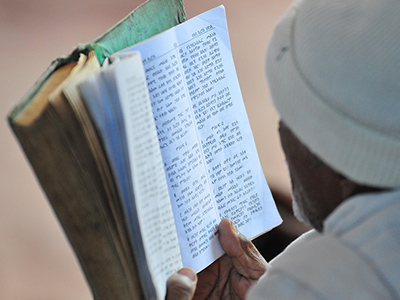
Many travellers do not take much time to visit Tigray’s rock-hewn churches. However less known than their Lalibela counterparts, the Tigray churches are in fact mostly older than the ones from “black Jerusalem”. Some date as far back as the 4th century. The Tigray churches are concentrated on a narrow perimeter between Tembien and Atsbi and the most astonishing of them are located in the Hausien and Geralta mountains. Often isolated in majestic natural surroundings difficult to access, it is not rare for the churches’ visitors to find themselves alone in locations where time seems to have stopped, confronted to scenes that seem straight out of the biblical times.
The Geralta and Hausien imposing massives shelter over a quarter of Tigray’s rock-hewn churches, including the most spectacular of them. It is in the heart of these Grand Canyon-like steep cliffs that the jewels of Ethiopian cave art are neatly hidden - and their exploration often comes at the prize of a considerable climbing effort. It is the perfect place to combine cultural visits with amazing trekking routes.
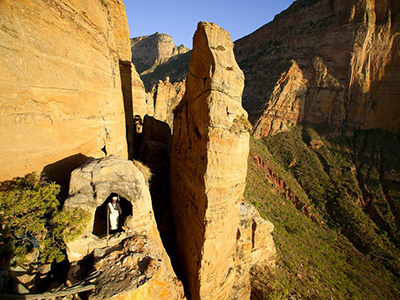
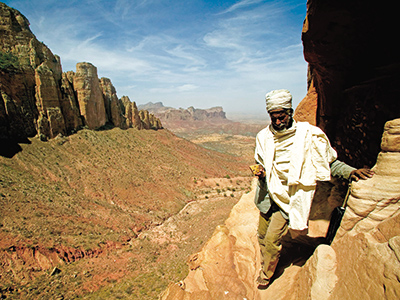
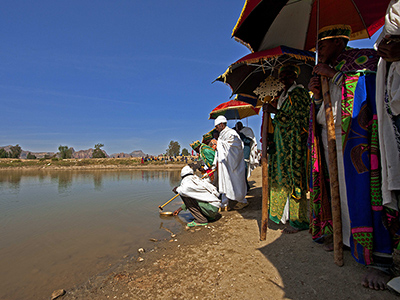
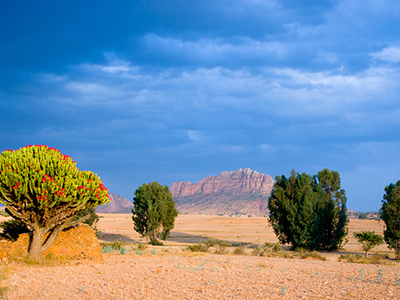
Let us know about your wishes and receive a tailor-made travel recommendation designed accordingly.